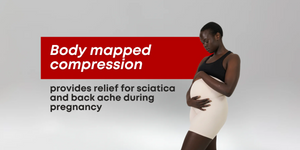Body mapped compression can be very beneficial for pregnant women experiencing sciatica and back ache. Compression garments provide targeted pressure to specific areas of the body, helping to reduce inflammation and pain.
Sciatica is caused by pressure on the sciatic nerve, which can be exacerbated during pregnancy due to the extra weight and pressure on the lower back. Targeted compression on the lower back and hips can help to alleviate this pressure and reduce pain.
Back ache is also common during pregnancy as the weight of the growing baby can strain the back muscles. Compression garments can help support the lower back and improve posture, reducing the strain on the muscles and easing discomfort.
By using body mapped compression garments, pregnant women can get targeted support and relief for their specific pain points. It is important to choose compression garments that are designed specifically for pregnancy and are comfortable to wear for extended periods of time. Supacore has developed a patented technology to assist pregnant women with a proprietary flex zone for the expanding tummy.
Always consult with a healthcare professional before trying any new treatment or product during pregnancy.
It is important for pregnant women to stay active and maintain a healthy lifestyle, but it is also important to choose exercises that are safe and appropriate for pregnancy.
Here are some exercises that are generally considered safe and beneficial for pregnant women:
1. Walking: Walking is a low-impact exercise that is safe for almost all pregnant women. It can help improve circulation, increase energy, and reduce stress.
2. Swimming: Swimming is another low-impact exercise that is great for pregnant women. It can help improve cardiovascular health, build strength, and reduce swelling.
3. Prenatal yoga: Prenatal yoga is designed specifically for pregnant women and can help improve flexibility, reduce stress, and prepare the body for childbirth.
4. Resistance training: Resistance training with light weights or resistance bands can help strengthen muscles and improve posture, which can help reduce back pain and other pregnancy-related discomforts.
5. Pelvic floor exercises: Pelvic floor exercises, also known as Kegels, can help strengthen the muscles that support the bladder, uterus, and bowel. This can help prevent urinary incontinence and prepare the body for childbirth.
It is important to always consult with a healthcare professional before starting or continuing an exercise routine during pregnancy.

|
| PATENTED CORETECH® EMMA PREGNANCY SUPPORT SHORTS |
1. A study published in the Journal of Obstetrics and Gynaecology Research found that body-mapped compression garments reduced pain and discomfort in pregnant women with low back pain. (Source: https://pubmed.ncbi.nlm.nih.gov/30815962/)
2. The American College of Obstetricians and Gynecologists (ACOG) recommends that pregnant women engage in at least 150 minutes of moderate-intensity aerobic exercise per week, as long as there are no medical or obstetric complications. (Source: https://www.acog.org/clinical/clinical-guidance/committee-opinion/articles/2020/04/physical-activity-and-exercise-during-pregnancy-and-the-postpartum-period)
3. A review of studies published in the Journal of Pregnancy found that prenatal yoga can improve maternal and fetal outcomes, including reducing stress and anxiety, improving sleep, and reducing the risk of preterm labor. (Source: https://www.ncbi.nlm.nih.gov/pmc/articles/PMC6928299/)
4. The ACOG also recommends that pregnant women engage in resistance training with light weights or resistance bands to improve muscular strength and endurance. (Source: https://www.acog.org/clinical/clinical-guidance/committee-opinion/articles/2015/11/physical-activity-and-exercise-during-pregnancy-and-the-postpartum-period)
5. The National Institute of Child Health and Human Development (NICHD) recommends that pregnant women do pelvic floor exercises, also known as Kegels, to help prevent urinary incontinence and other pelvic floor disorders. (Source: https://www.nichd.nih.gov/health/topics/pelvicfloor/conditioninfo/pregnancy)

